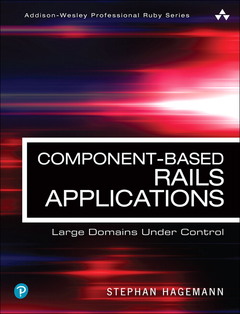Description
Component-Based Rails Applications
Large Domains Under Control
Addison-Wesley Professional Ruby Series
Author: Hagemann Stephan
Language: English
Subject for Component-Based Rails Applications:
304 p. · 17.6x23.2 cm · Paperback
Description
/li>Contents
/li>Biography
/li>Comment
/li>
Use Components to Improve Maintainability, Reduce Complexity, and Accelerate Testing in Large Rails Applications
?This book gives Ruby pros a comprehensive guide for increasing the sophistication of their designs, without having to forsake the principles of elegance that keep them in our corner of the software world.?
?Obie Fernandez, author, The RailsTM 5 Way, Fourth Edition
As Rails applications grow, even experienced developers find it difficult to navigate code bases, implement new features, and keep tests fast. Components are the solution, and Component-Based Rails Applications shows how to make the most of them.
Writing for programmers and software team leads who are comfortable with Ruby and Rails, Stephan Hagemann introduces a practical, start-to-finish methodology for modernizing and restructuring existing Rails applications.
One step at a time, Hagemann demonstrates how to revamp Rails applications to exhibit visible, provably independent, and explicitly connected parts?thereby simplifying them and making them far easier for teams to manage, change, and test. Throughout, he introduces design concepts and techniques you can use to improve applications of many kinds, even if they weren?t built with Rails or Ruby.
- Learn how components clarify intent, improve collaboration, and simplify innovation and maintenance
- Create a full Rails application within a component, from first steps to migrations and dependency management
- Test component-based applications, manage assets and dependencies, and deploy your application to production
- Identify the seams in an existing Rails application, and refactor it to extract components
- Master a scripted, repeatable approach for refactoring Rails applications of any size
- Use component-based Rails with two popular structural patterns: hexagonal and DCI architecture
- Leverage your new component skills with other frameworks and languages
- Overcome the unique challenges that arise as you componentize Rails applications
If you?re ready to simplify and revitalize your complex Rails systems, you?re ready for Component-Based Rails Applications.
Register your book for convenient access to downloads, updates, and/or corrections as they become available. See inside book for details.
Foreword xi
Preface xiii
Acknowledgments xxi
About the Author xxiii
Chapter 1: Introduction to Component-Based Rails Applications 1
1.1 Component-Based Rails 2
1.2 Benefits of Component-Based Applications 4
1.3 Component-Based Ruby 13
1.4 The Application Continuum 14
1.5 Related Works 15
Chapter 2: Creating a Component-Based Application 17
2.1 The Entire App Inside a Component 18
2.2 ActiveRecord and Handling Migrations within Components 27
2.3 Handling Dependencies within Components 34
Chapter 3: Tooling for Components 49
3.1 Testing a Component 50
3.2 Testing the Main Application 65
3.3 Asset Loading for Components 74
3.4 Switching Databases 82
3.5 Deploying to Platforms-as-a-Service 86
3.6 Updating Application Dependencies 90
3.7 Proposal for a Different Application Root—Showcasing the Difference of Components’ Structure 99
Chapter 4: Component Refactorings: Extracting Components Out of Components 111
4.1 Determining What to Extract: Bottom-Up 112
4.2 Refactoring: Extract Domain Gem—Predictor 120
4.3 Determining What to Extract: Top-Down 139
4.4 Refactoring: Pulling Up a UI Component—TeamsAdmin, GamesAdmin, PredictionUI, WelcomeUI 150
4.5 Refactoring: Pushing Down a Model Component—Teams, Games 168
4.6 Refactoring: Improve Naming of Component—AppComponent to WebUI 183
4.7 More Component Refactoring Patterns 189
Chapter 5: From Ball of Mud to First Components 195
5.1 Small Steps 196
5.2 One Big Step 196
Chapter 6: Component-Based Rails in Relation to Other Patterns 211
6.1 Hexagonal Architecture 212
6.2 Data-Context-Integration (DCI) 227
Chapter 7: Components in Other Languages 237
7.1 Kotlin, Java, and Gradle 238
7.2 .NET / C 241
7.3 Conclusion 243
Appendix 245
A.1 Plain versus --full versus --mountable Engines 245
A.2 How Do Engine Routes and Engine Mounting Work? 254
A.3 Additional Testing with Older Versions of Rails 261
Index 265
Stephan Hagemann most recently has been supporting clients of Pivotal Software in journeys of digital transformation. In these, organizational change is as much a topic as the implementation of Agile processes and software system architecture. This work grew out of Stephan’s previous management and engineering roles within Pivotal Labs, Pivotal’s software consulting group. Prior to joining Pivotal, Stephan moved to the United States from Germany where he worked as a software engineer for xing. He has a doctorate in information systems from the University of Münster in Germany.
Use components to solve the problems faced by every large and growing Rails application: maintainability, complexity, and testing
- The first realistic guide to modernizing and improving the Rails applications your organization depends on
- A breakthrough resource for all developers who need to level up their skills for large-scale application environments -- in Rails, Ruby, and beyond
- Introduces new refactoring techniques for extracting components from existing applications
- Shows how to leverage powerful architectural patterns such as DCI and hexagonal architecture
- The newest title in the well-respected Addison-Wesley Professional Ruby Series
These books may interest you

Ruby on Rails Tutorial 49.42 €



